Nursing Case Study: Aboriginal and Torres Strait Islander Health
VerifiedAdded on 2023/06/09
|7
|1383
|53
Case Study
AI Summary
This nursing case study examines the experiences of Luke, an Aboriginal and Torres Strait Islander university student, focusing on the social determinants of health affecting his well-being. It addresses the influence of social gradient, early life experiences, social exclusion, and lack of social support on his mental health. The study highlights the impact of the Youth Employment Policy 2016 and the significance of cultural factors in shaping Luke's identity and health beliefs. It further explores the challenges Luke faces in accessing mainstream healthcare services due to racial discrimination, cultural barriers, and language issues, suggesting culturally safe approaches for health professionals. The study emphasizes the importance of cultural safety principles, including knowledge of Aboriginal culture, informed consent, and culturally appropriate materials, for providing culturally sensitive care. Desklib offers similar case studies and resources for nursing students.
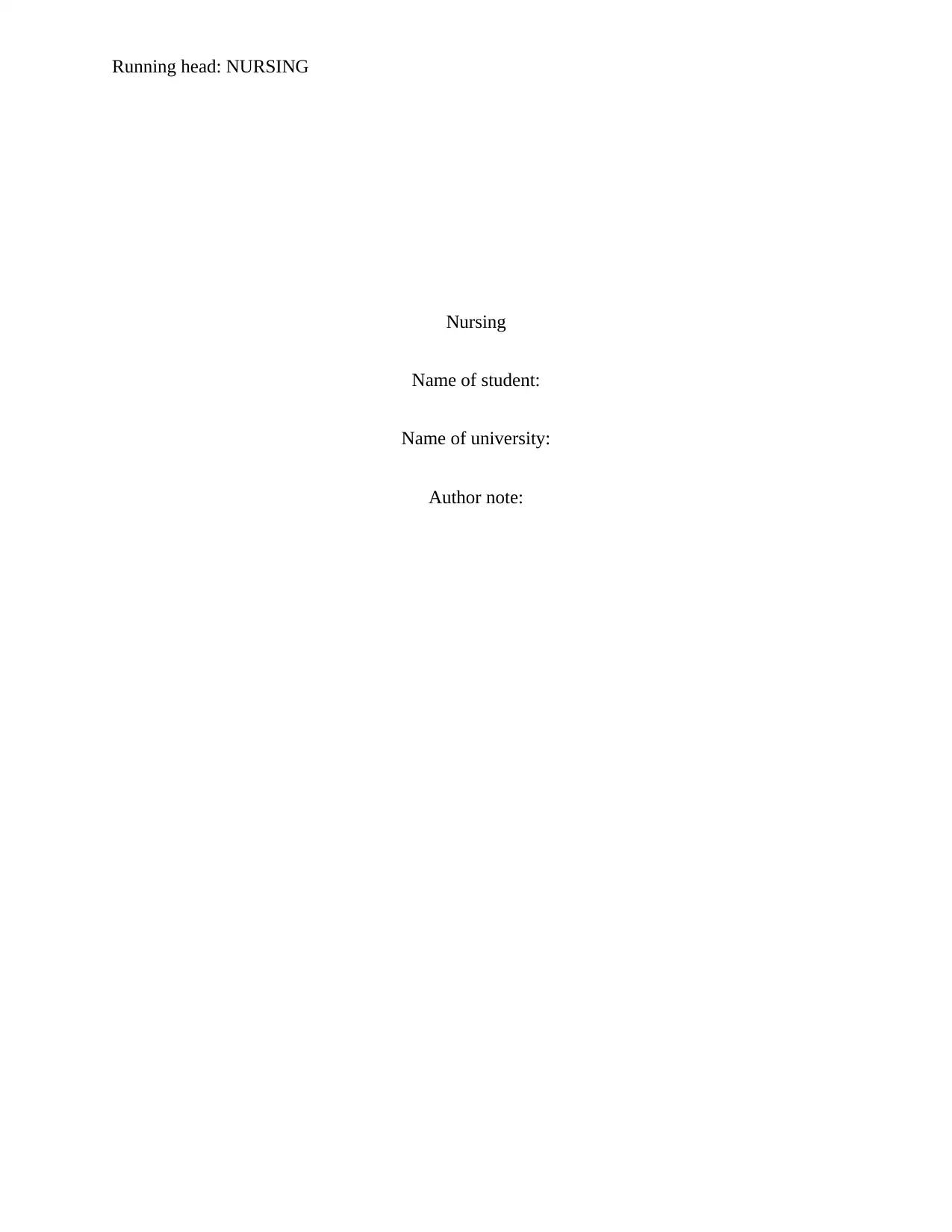
Running head: NURSING
Nursing
Name of student:
Name of university:
Author note:
Nursing
Name of student:
Name of university:
Author note:
Paraphrase This Document
Need a fresh take? Get an instant paraphrase of this document with our AI Paraphraser
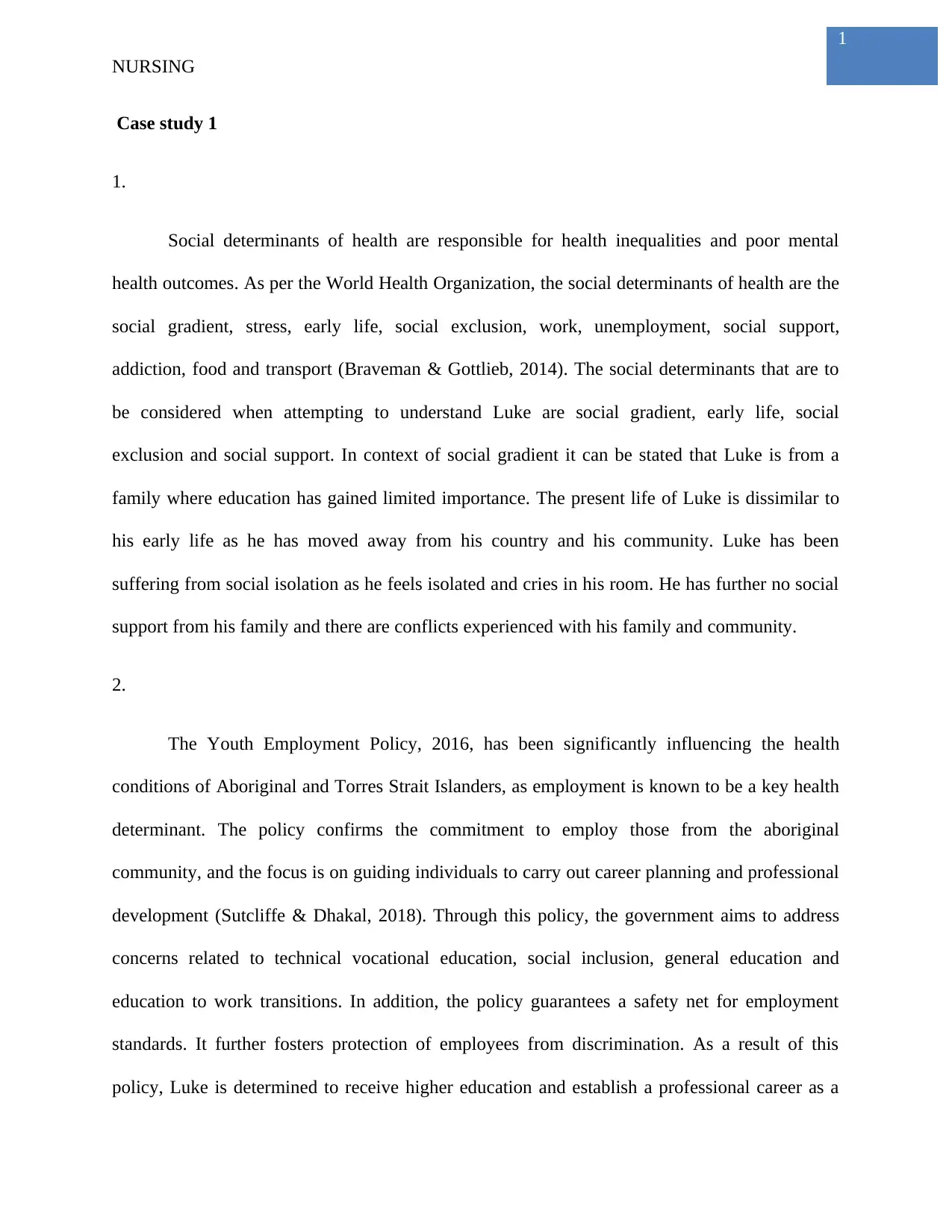
1
NURSING
Case study 1
1.
Social determinants of health are responsible for health inequalities and poor mental
health outcomes. As per the World Health Organization, the social determinants of health are the
social gradient, stress, early life, social exclusion, work, unemployment, social support,
addiction, food and transport (Braveman & Gottlieb, 2014). The social determinants that are to
be considered when attempting to understand Luke are social gradient, early life, social
exclusion and social support. In context of social gradient it can be stated that Luke is from a
family where education has gained limited importance. The present life of Luke is dissimilar to
his early life as he has moved away from his country and his community. Luke has been
suffering from social isolation as he feels isolated and cries in his room. He has further no social
support from his family and there are conflicts experienced with his family and community.
2.
The Youth Employment Policy, 2016, has been significantly influencing the health
conditions of Aboriginal and Torres Strait Islanders, as employment is known to be a key health
determinant. The policy confirms the commitment to employ those from the aboriginal
community, and the focus is on guiding individuals to carry out career planning and professional
development (Sutcliffe & Dhakal, 2018). Through this policy, the government aims to address
concerns related to technical vocational education, social inclusion, general education and
education to work transitions. In addition, the policy guarantees a safety net for employment
standards. It further fosters protection of employees from discrimination. As a result of this
policy, Luke is determined to receive higher education and establish a professional career as a
NURSING
Case study 1
1.
Social determinants of health are responsible for health inequalities and poor mental
health outcomes. As per the World Health Organization, the social determinants of health are the
social gradient, stress, early life, social exclusion, work, unemployment, social support,
addiction, food and transport (Braveman & Gottlieb, 2014). The social determinants that are to
be considered when attempting to understand Luke are social gradient, early life, social
exclusion and social support. In context of social gradient it can be stated that Luke is from a
family where education has gained limited importance. The present life of Luke is dissimilar to
his early life as he has moved away from his country and his community. Luke has been
suffering from social isolation as he feels isolated and cries in his room. He has further no social
support from his family and there are conflicts experienced with his family and community.
2.
The Youth Employment Policy, 2016, has been significantly influencing the health
conditions of Aboriginal and Torres Strait Islanders, as employment is known to be a key health
determinant. The policy confirms the commitment to employ those from the aboriginal
community, and the focus is on guiding individuals to carry out career planning and professional
development (Sutcliffe & Dhakal, 2018). Through this policy, the government aims to address
concerns related to technical vocational education, social inclusion, general education and
education to work transitions. In addition, the policy guarantees a safety net for employment
standards. It further fosters protection of employees from discrimination. As a result of this
policy, Luke is determined to receive higher education and establish a professional career as a
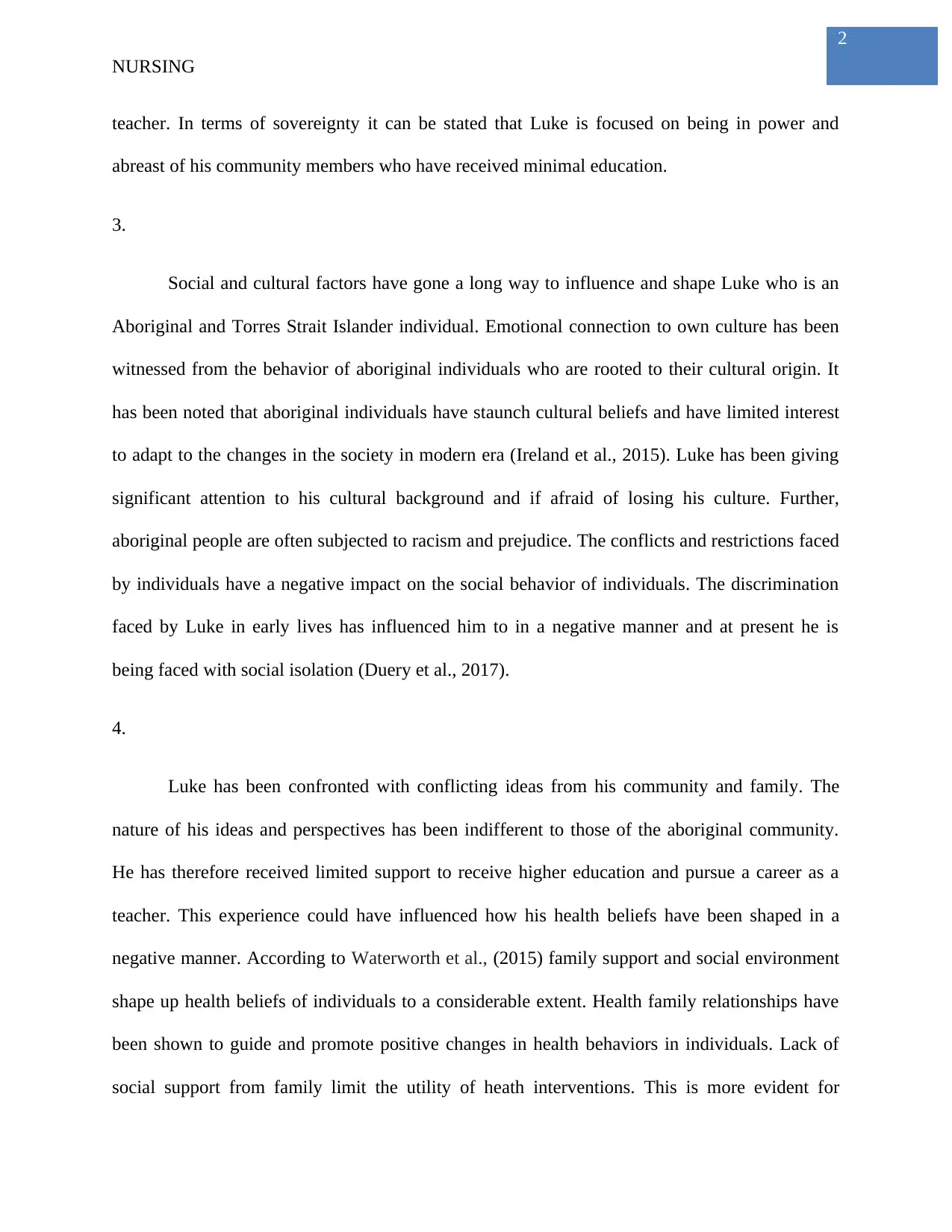
2
NURSING
teacher. In terms of sovereignty it can be stated that Luke is focused on being in power and
abreast of his community members who have received minimal education.
3.
Social and cultural factors have gone a long way to influence and shape Luke who is an
Aboriginal and Torres Strait Islander individual. Emotional connection to own culture has been
witnessed from the behavior of aboriginal individuals who are rooted to their cultural origin. It
has been noted that aboriginal individuals have staunch cultural beliefs and have limited interest
to adapt to the changes in the society in modern era (Ireland et al., 2015). Luke has been giving
significant attention to his cultural background and if afraid of losing his culture. Further,
aboriginal people are often subjected to racism and prejudice. The conflicts and restrictions faced
by individuals have a negative impact on the social behavior of individuals. The discrimination
faced by Luke in early lives has influenced him to in a negative manner and at present he is
being faced with social isolation (Duery et al., 2017).
4.
Luke has been confronted with conflicting ideas from his community and family. The
nature of his ideas and perspectives has been indifferent to those of the aboriginal community.
He has therefore received limited support to receive higher education and pursue a career as a
teacher. This experience could have influenced how his health beliefs have been shaped in a
negative manner. According to Waterworth et al., (2015) family support and social environment
shape up health beliefs of individuals to a considerable extent. Health family relationships have
been shown to guide and promote positive changes in health behaviors in individuals. Lack of
social support from family limit the utility of heath interventions. This is more evident for
NURSING
teacher. In terms of sovereignty it can be stated that Luke is focused on being in power and
abreast of his community members who have received minimal education.
3.
Social and cultural factors have gone a long way to influence and shape Luke who is an
Aboriginal and Torres Strait Islander individual. Emotional connection to own culture has been
witnessed from the behavior of aboriginal individuals who are rooted to their cultural origin. It
has been noted that aboriginal individuals have staunch cultural beliefs and have limited interest
to adapt to the changes in the society in modern era (Ireland et al., 2015). Luke has been giving
significant attention to his cultural background and if afraid of losing his culture. Further,
aboriginal people are often subjected to racism and prejudice. The conflicts and restrictions faced
by individuals have a negative impact on the social behavior of individuals. The discrimination
faced by Luke in early lives has influenced him to in a negative manner and at present he is
being faced with social isolation (Duery et al., 2017).
4.
Luke has been confronted with conflicting ideas from his community and family. The
nature of his ideas and perspectives has been indifferent to those of the aboriginal community.
He has therefore received limited support to receive higher education and pursue a career as a
teacher. This experience could have influenced how his health beliefs have been shaped in a
negative manner. According to Waterworth et al., (2015) family support and social environment
shape up health beliefs of individuals to a considerable extent. Health family relationships have
been shown to guide and promote positive changes in health behaviors in individuals. Lack of
social support from family limit the utility of heath interventions. This is more evident for
⊘ This is a preview!⊘
Do you want full access?
Subscribe today to unlock all pages.

Trusted by 1+ million students worldwide
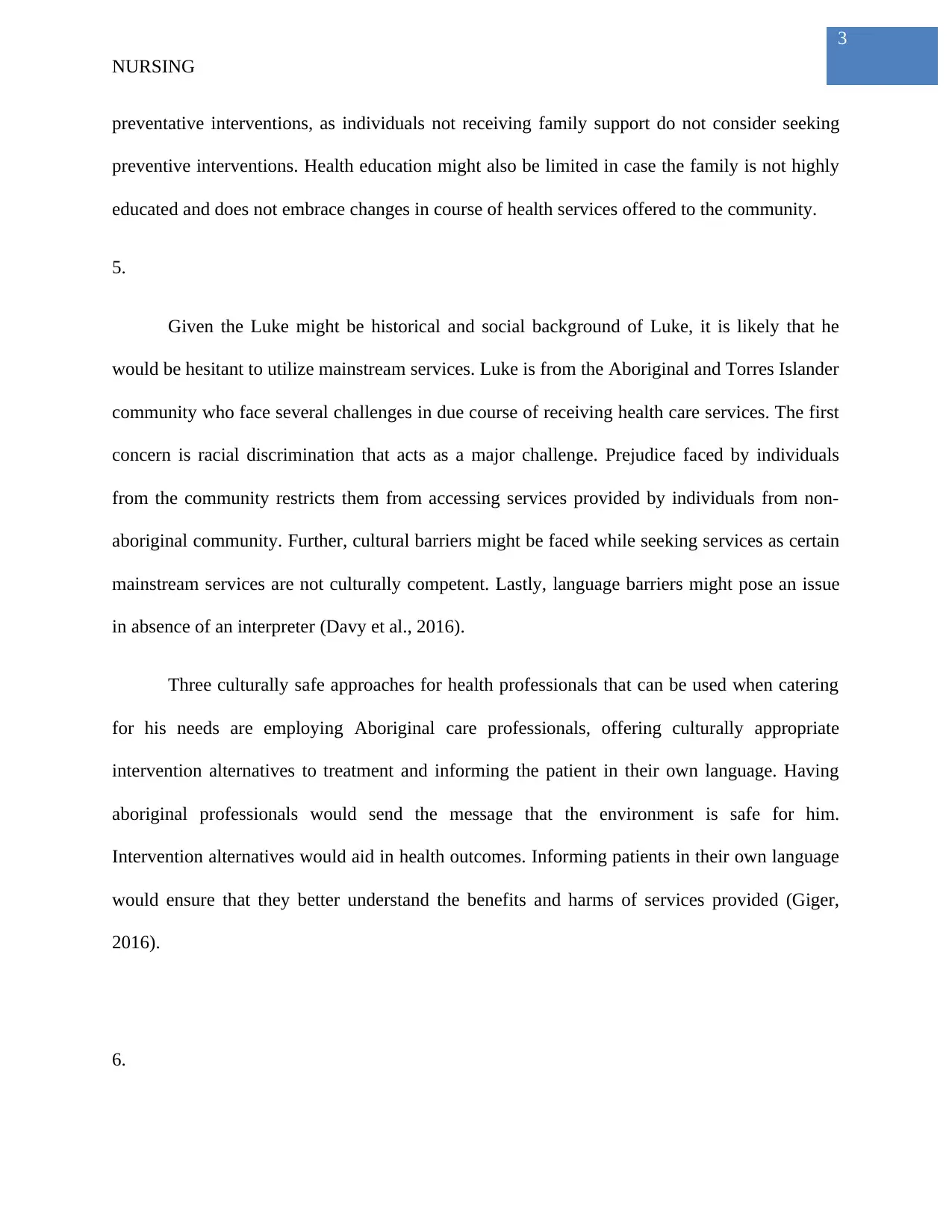
3
NURSING
preventative interventions, as individuals not receiving family support do not consider seeking
preventive interventions. Health education might also be limited in case the family is not highly
educated and does not embrace changes in course of health services offered to the community.
5.
Given the Luke might be historical and social background of Luke, it is likely that he
would be hesitant to utilize mainstream services. Luke is from the Aboriginal and Torres Islander
community who face several challenges in due course of receiving health care services. The first
concern is racial discrimination that acts as a major challenge. Prejudice faced by individuals
from the community restricts them from accessing services provided by individuals from non-
aboriginal community. Further, cultural barriers might be faced while seeking services as certain
mainstream services are not culturally competent. Lastly, language barriers might pose an issue
in absence of an interpreter (Davy et al., 2016).
Three culturally safe approaches for health professionals that can be used when catering
for his needs are employing Aboriginal care professionals, offering culturally appropriate
intervention alternatives to treatment and informing the patient in their own language. Having
aboriginal professionals would send the message that the environment is safe for him.
Intervention alternatives would aid in health outcomes. Informing patients in their own language
would ensure that they better understand the benefits and harms of services provided (Giger,
2016).
6.
NURSING
preventative interventions, as individuals not receiving family support do not consider seeking
preventive interventions. Health education might also be limited in case the family is not highly
educated and does not embrace changes in course of health services offered to the community.
5.
Given the Luke might be historical and social background of Luke, it is likely that he
would be hesitant to utilize mainstream services. Luke is from the Aboriginal and Torres Islander
community who face several challenges in due course of receiving health care services. The first
concern is racial discrimination that acts as a major challenge. Prejudice faced by individuals
from the community restricts them from accessing services provided by individuals from non-
aboriginal community. Further, cultural barriers might be faced while seeking services as certain
mainstream services are not culturally competent. Lastly, language barriers might pose an issue
in absence of an interpreter (Davy et al., 2016).
Three culturally safe approaches for health professionals that can be used when catering
for his needs are employing Aboriginal care professionals, offering culturally appropriate
intervention alternatives to treatment and informing the patient in their own language. Having
aboriginal professionals would send the message that the environment is safe for him.
Intervention alternatives would aid in health outcomes. Informing patients in their own language
would ensure that they better understand the benefits and harms of services provided (Giger,
2016).
6.
Paraphrase This Document
Need a fresh take? Get an instant paraphrase of this document with our AI Paraphraser
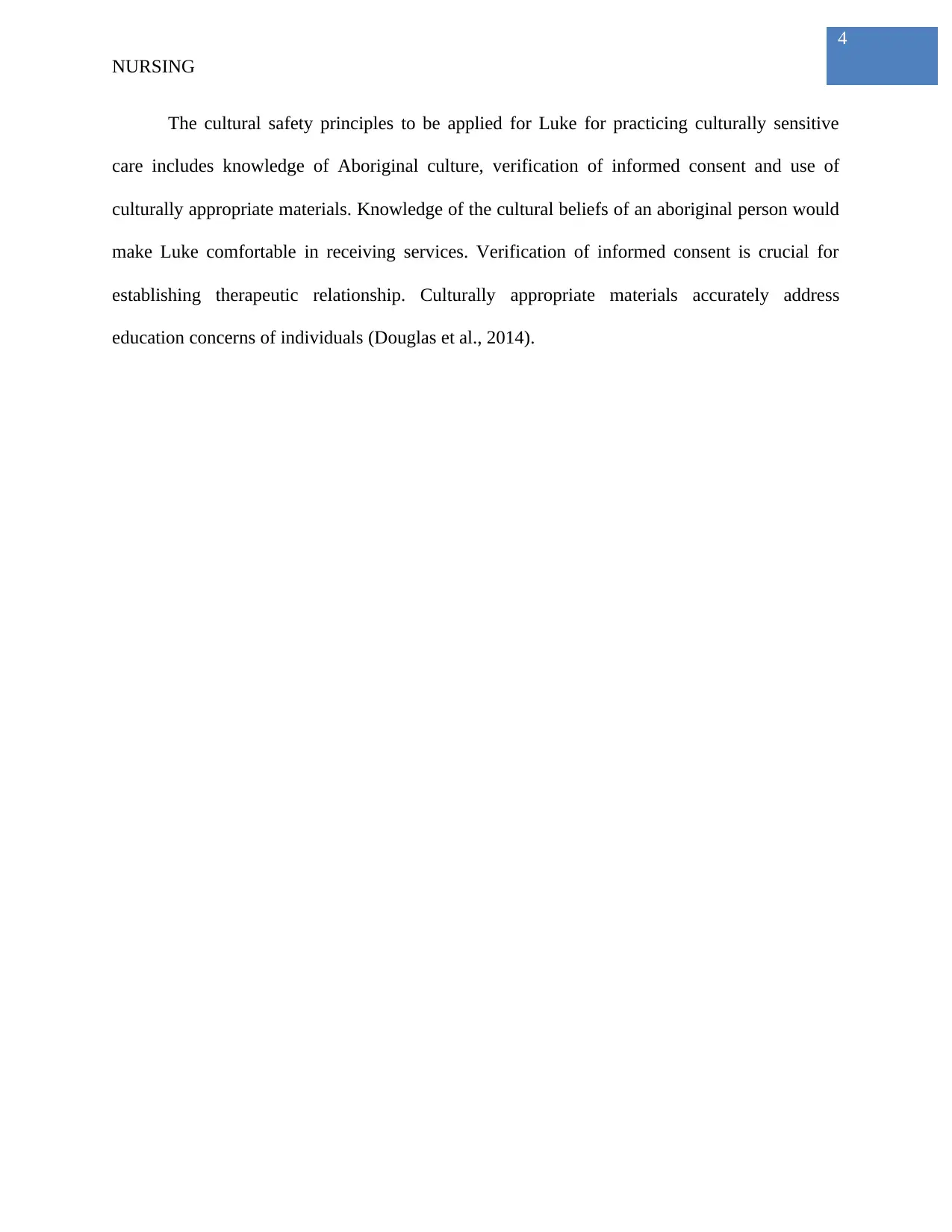
4
NURSING
The cultural safety principles to be applied for Luke for practicing culturally sensitive
care includes knowledge of Aboriginal culture, verification of informed consent and use of
culturally appropriate materials. Knowledge of the cultural beliefs of an aboriginal person would
make Luke comfortable in receiving services. Verification of informed consent is crucial for
establishing therapeutic relationship. Culturally appropriate materials accurately address
education concerns of individuals (Douglas et al., 2014).
NURSING
The cultural safety principles to be applied for Luke for practicing culturally sensitive
care includes knowledge of Aboriginal culture, verification of informed consent and use of
culturally appropriate materials. Knowledge of the cultural beliefs of an aboriginal person would
make Luke comfortable in receiving services. Verification of informed consent is crucial for
establishing therapeutic relationship. Culturally appropriate materials accurately address
education concerns of individuals (Douglas et al., 2014).
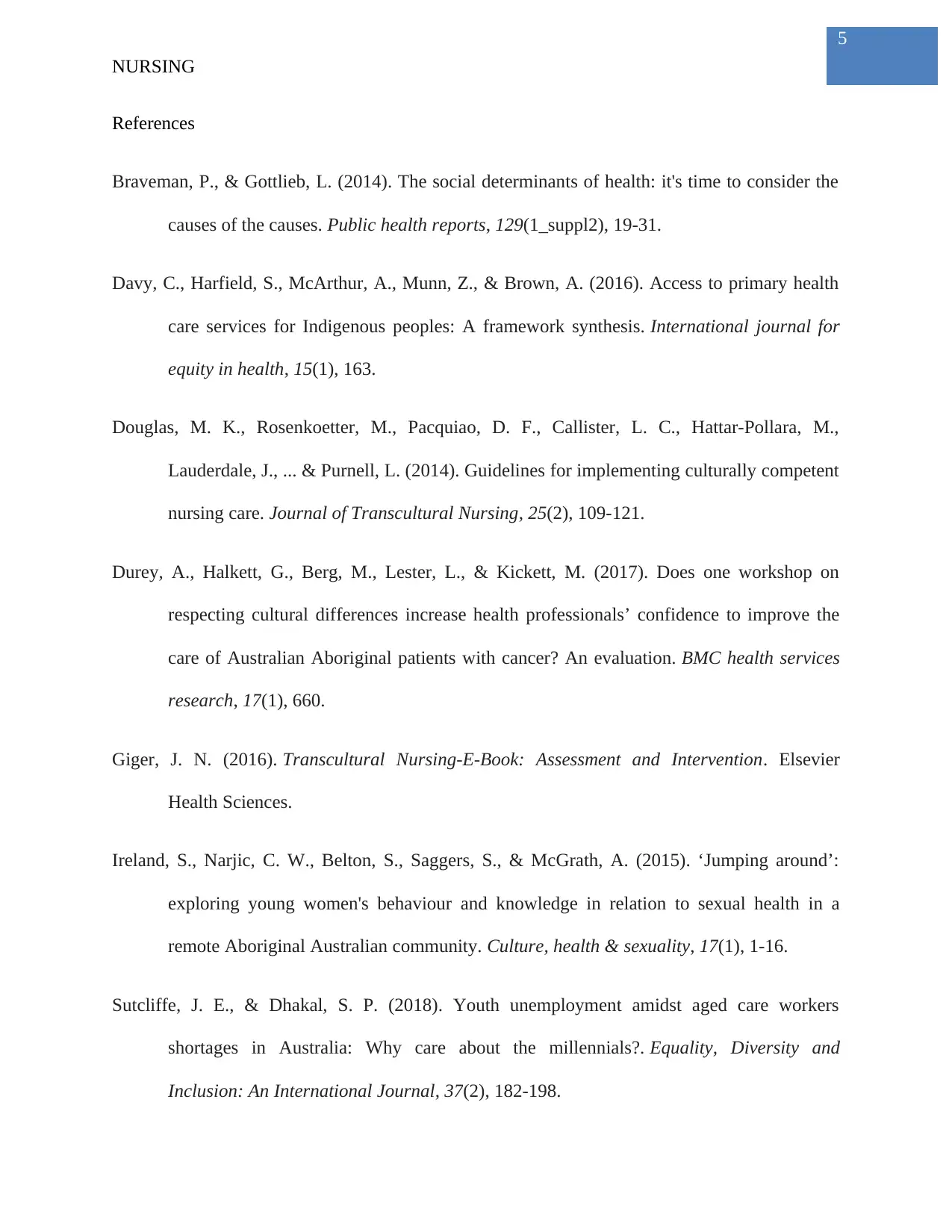
5
NURSING
References
Braveman, P., & Gottlieb, L. (2014). The social determinants of health: it's time to consider the
causes of the causes. Public health reports, 129(1_suppl2), 19-31.
Davy, C., Harfield, S., McArthur, A., Munn, Z., & Brown, A. (2016). Access to primary health
care services for Indigenous peoples: A framework synthesis. International journal for
equity in health, 15(1), 163.
Douglas, M. K., Rosenkoetter, M., Pacquiao, D. F., Callister, L. C., Hattar-Pollara, M.,
Lauderdale, J., ... & Purnell, L. (2014). Guidelines for implementing culturally competent
nursing care. Journal of Transcultural Nursing, 25(2), 109-121.
Durey, A., Halkett, G., Berg, M., Lester, L., & Kickett, M. (2017). Does one workshop on
respecting cultural differences increase health professionals’ confidence to improve the
care of Australian Aboriginal patients with cancer? An evaluation. BMC health services
research, 17(1), 660.
Giger, J. N. (2016). Transcultural Nursing-E-Book: Assessment and Intervention. Elsevier
Health Sciences.
Ireland, S., Narjic, C. W., Belton, S., Saggers, S., & McGrath, A. (2015). ‘Jumping around’:
exploring young women's behaviour and knowledge in relation to sexual health in a
remote Aboriginal Australian community. Culture, health & sexuality, 17(1), 1-16.
Sutcliffe, J. E., & Dhakal, S. P. (2018). Youth unemployment amidst aged care workers
shortages in Australia: Why care about the millennials?. Equality, Diversity and
Inclusion: An International Journal, 37(2), 182-198.
NURSING
References
Braveman, P., & Gottlieb, L. (2014). The social determinants of health: it's time to consider the
causes of the causes. Public health reports, 129(1_suppl2), 19-31.
Davy, C., Harfield, S., McArthur, A., Munn, Z., & Brown, A. (2016). Access to primary health
care services for Indigenous peoples: A framework synthesis. International journal for
equity in health, 15(1), 163.
Douglas, M. K., Rosenkoetter, M., Pacquiao, D. F., Callister, L. C., Hattar-Pollara, M.,
Lauderdale, J., ... & Purnell, L. (2014). Guidelines for implementing culturally competent
nursing care. Journal of Transcultural Nursing, 25(2), 109-121.
Durey, A., Halkett, G., Berg, M., Lester, L., & Kickett, M. (2017). Does one workshop on
respecting cultural differences increase health professionals’ confidence to improve the
care of Australian Aboriginal patients with cancer? An evaluation. BMC health services
research, 17(1), 660.
Giger, J. N. (2016). Transcultural Nursing-E-Book: Assessment and Intervention. Elsevier
Health Sciences.
Ireland, S., Narjic, C. W., Belton, S., Saggers, S., & McGrath, A. (2015). ‘Jumping around’:
exploring young women's behaviour and knowledge in relation to sexual health in a
remote Aboriginal Australian community. Culture, health & sexuality, 17(1), 1-16.
Sutcliffe, J. E., & Dhakal, S. P. (2018). Youth unemployment amidst aged care workers
shortages in Australia: Why care about the millennials?. Equality, Diversity and
Inclusion: An International Journal, 37(2), 182-198.
⊘ This is a preview!⊘
Do you want full access?
Subscribe today to unlock all pages.

Trusted by 1+ million students worldwide
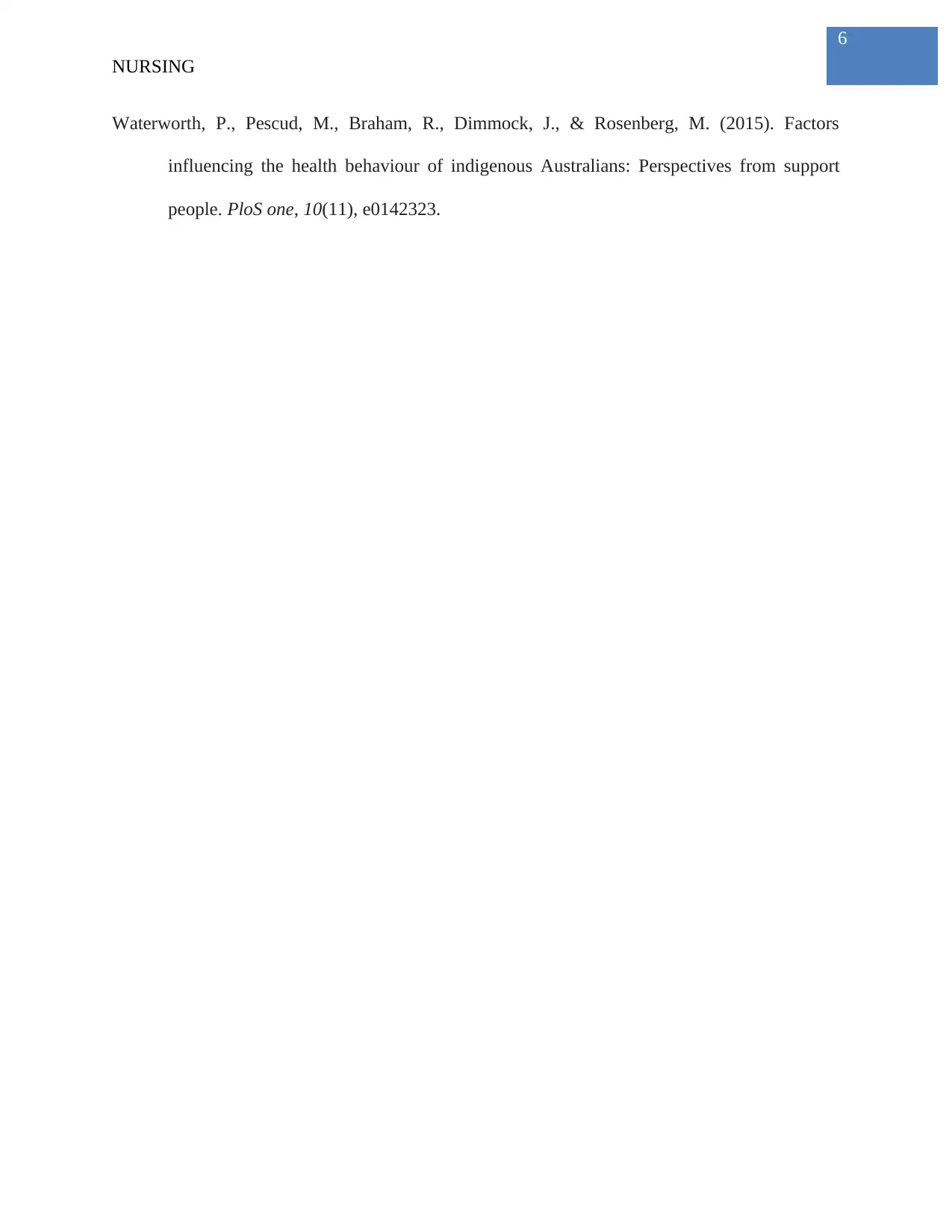
6
NURSING
Waterworth, P., Pescud, M., Braham, R., Dimmock, J., & Rosenberg, M. (2015). Factors
influencing the health behaviour of indigenous Australians: Perspectives from support
people. PloS one, 10(11), e0142323.
NURSING
Waterworth, P., Pescud, M., Braham, R., Dimmock, J., & Rosenberg, M. (2015). Factors
influencing the health behaviour of indigenous Australians: Perspectives from support
people. PloS one, 10(11), e0142323.
1 out of 7
Related Documents
Your All-in-One AI-Powered Toolkit for Academic Success.
+13062052269
info@desklib.com
Available 24*7 on WhatsApp / Email
![[object Object]](/_next/static/media/star-bottom.7253800d.svg)
Unlock your academic potential
Copyright © 2020–2025 A2Z Services. All Rights Reserved. Developed and managed by ZUCOL.




